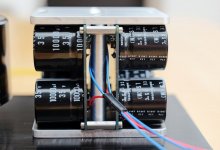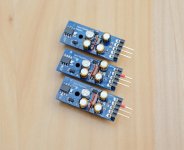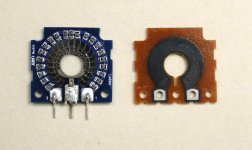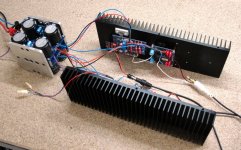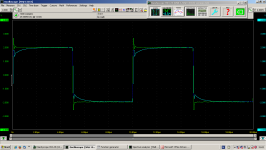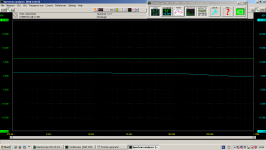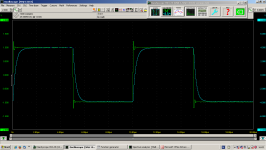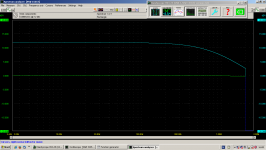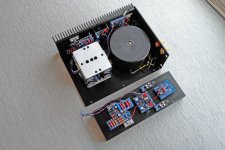Personaly i machined hard alu alloy pieces to sandwich the jfet to heatsink with one screw either side
That is the preferred solution. Problem is I have limited machining access, especially metal. So I choose the lazy way. Patrick already set my head straight.
You can preheat the JFET and copper to 150 degC in an oven and then use a 200W iron and leaded solder.
Won't take 5 seconds, so quicker than a wave solder cycle for mass production.
Patrick
Won't take 5 seconds, so quicker than a wave solder cycle for mass production.
Patrick
A few more images:
'Da Bomb', the capacitor bank with integrated cap multipliers (four of them!)
Heat spreaders top and bottom connected with aluminum rods to transfer the heat to the bottom plate of the case.
'Da Bomb', the capacitor bank with integrated cap multipliers (four of them!)
Heat spreaders top and bottom connected with aluminum rods to transfer the heat to the bottom plate of the case.
Attachments
A few more images:
'Da Bomb', the capacitor bank with integrated cap multipliers (four of them!)
Heat spreaders top and bottom connected with aluminum rods to transfer the heat to the bottom plate of the case.
...love the name "Da bomb"....😀
The cap multipliers are 317_337 based as used in the F5-HA.
The Didden Regulators are not the standard version but a XEN modified version.
Jan was given the first ever pair a couple of years ago to measure / treasure. 🙂
The pin out as shown by Oliver is 78xx / 79xx compatible, with two addition optional sense pins.
Overall size is ~ 13x35mm, with a TO220 power device which can be mounted to a heat sink at the back.
You can see the mounting hole clearly on the PCB.
It uses degenerated 2SK209s for the two CCS, and a JFET input opamp such as OPA1641.
The LM329s are replaced by 3x SMD red LED in series.
And the power supply to the opamp is decoupled at HF from the regulator output.
This, IMHO, enhances stability greatly, so that it has no issue with low ESR output caps.
The audio caps I tried such as Nichicon KA or Elna Silmic II are all fine.
Patrick
The Didden Regulators are not the standard version but a XEN modified version.
Jan was given the first ever pair a couple of years ago to measure / treasure. 🙂
The pin out as shown by Oliver is 78xx / 79xx compatible, with two addition optional sense pins.
Overall size is ~ 13x35mm, with a TO220 power device which can be mounted to a heat sink at the back.
You can see the mounting hole clearly on the PCB.
It uses degenerated 2SK209s for the two CCS, and a JFET input opamp such as OPA1641.
The LM329s are replaced by 3x SMD red LED in series.
And the power supply to the opamp is decoupled at HF from the regulator output.
This, IMHO, enhances stability greatly, so that it has no issue with low ESR output caps.
The audio caps I tried such as Nichicon KA or Elna Silmic II are all fine.
Patrick
If you ever do a run of pcb for the regulators, do many of them, I am sure they will not be wasted. I would take few of them.
D.
D.
XEN modified RK27 Ladder
The idea was described one year ago.
http://www.diyaudio.com/forums/head...ss-zgf-headphone-amplifier-4.html#post4347276
Now finally the real thing, shown next to the original ALPS carbon track wafer.
The build was actually much easier than I anticipated.
And only one word for the result ..... transparent.
Patrick
.
The idea was described one year ago.
http://www.diyaudio.com/forums/head...ss-zgf-headphone-amplifier-4.html#post4347276
Now finally the real thing, shown next to the original ALPS carbon track wafer.
The build was actually much easier than I anticipated.
And only one word for the result ..... transparent.
Patrick
.
Attachments
Stixx's proto is singing.
Noise issue with the HAGS now completely solved.
Background totally dark.
HAGS bandwidth is 700kHz -3dB, nice first order drop.
DAO TCS has 400kHz bandwidth at -1dB.
(My func gen cannot go much higher without large overshoot)
So everything works as planned. 😉
Patrick
.
Noise issue with the HAGS now completely solved.
Background totally dark.
HAGS bandwidth is 700kHz -3dB, nice first order drop.
DAO TCS has 400kHz bandwidth at -1dB.
(My func gen cannot go much higher without large overshoot)
So everything works as planned. 😉
Patrick
.
Attachments
Any updated circuit yet using the BJT instead of 2SJ103 in the Taylor current source? I tried some time ago to use a BJT in my SPICE model and found dramatically increased distortion.
Just replace the 2SJ74 with 2SA970BL in the published schematics in pdf.
http://www.diyaudio.com/forums/head...ss-zgf-headphone-amplifier-2.html#post3297425
The 2SJ103 version is totally outdated.
Patrick
http://www.diyaudio.com/forums/head...ss-zgf-headphone-amplifier-2.html#post3297425
The 2SJ103 version is totally outdated.
Patrick
Last edited:
... and some of the Didden regs I am planning to use. Not finally decided... at least two for the Crossfeed.
where can I buy super regulators to replace standard 78xx 79xx
what are their current capabilities
Our version is only available as part of the project.
But you can buy larger ones from the DIYA store.
Thank you for your interest,
Patrick
But you can buy larger ones from the DIYA store.
Thank you for your interest,
Patrick
Probably the most 'sophisticated' regulator circuit I tried with the DAO amp and the AKGs was a 'beefer-up' Salas shunt reg (about 350mA) but reverted back to a well organised traditional C-R-C supply with the 'R' replaced by 'simple' C-Multiplier - to me, the regulators seemed to have maybe better transients and such but lacked a lot of 'air' and 'life' (PRAT I think they call it, sorry for the vague terms) - haven't changed it since which is most unusual for me!
I think a couple of guys tried those Jan Didden super-regulators and the older minimum feedback Pooge style ones but unsure of results - perhaps you might have more success with some of the newer types of fast, low noise chip regulators...
I think a couple of guys tried those Jan Didden super-regulators and the older minimum feedback Pooge style ones but unsure of results - perhaps you might have more success with some of the newer types of fast, low noise chip regulators...
Our version is only available as part of the project.
But you can buy larger ones from the DIYA store.
Thank you for your interest,
Patrick
thank you Patrick
I will look at larger ones but feel that I need the ones posted here and they can become bestsellers
Probably the most 'sophisticated' regulator circuit I tried with the DAO amp and the AKGs was a 'beefer-up' Salas shunt reg (about 350mA) but reverted back to a well organised traditional C-R-C supply with the 'R' replaced by 'simple' C-Multiplier - to me, the regulators seemed to have maybe better transients and such but lacked a lot of 'air' and 'life' (PRAT I think they call it, sorry for the vague terms) - haven't changed it since which is most unusual for me!
I think a couple of guys tried those Jan Didden super-regulators and the older minimum feedback Pooge style ones but unsure of results - perhaps you might have more success with some of the newer types of fast, low noise chip regulators...
thank you for advice
I like Salas BiB but It Is very big
Last edited:
- Home
- Amplifiers
- Headphone Systems
- The DAO SE all-FET Class-A ZGF Headphone Amplifier

